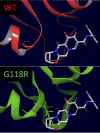The G118R plus R263K Combination of Integrase Mutations Associated with Dolutegravir-Based Treatment Failure Reduces HIV-1 Replicative Capacity and Integration
- PMID: 37071019
- PMCID: PMC10190594
- DOI: 10.1128/aac.01386-22
The G118R plus R263K Combination of Integrase Mutations Associated with Dolutegravir-Based Treatment Failure Reduces HIV-1 Replicative Capacity and Integration
Abstract
Human immunodeficiency virus (HIV) treatment with antiretroviral regimens containing integrase strand transfer inhibitors such as dolutegravir (DTG) and bictegravir (BIC) offers high levels of protection against the development of drug resistance mutations. Despite this, resistance to DTG and BIC can occur through the development of the R263K integrase substitution. Failure with DTG has also been associated with the emergence of the G118R substitution. G118R and R263K are usually found separately but have been reported together in highly treatment-experienced persons who experienced treatment failure with DTG. We used cell-free strand transfer and DNA binding assays and cell-based infectivity, replicative capacity, and resistance assays to characterize the G118R plus R263K combination of integrase mutations. R263K reduced DTG and BIC susceptibility ~2-fold, in agreement with our previous work. Single-cycle infectivity assays showed that G118R and G118R plus R263K conferred ~10-fold resistance to DTG. G118R alone conferred low levels of resistance to BIC (3.9-fold). However, the G118R plus R263K combination conferred high levels of resistance to BIC (33.7-fold), likely precluding the use of BIC after DTG failure with the G118R plus R263K combination. DNA binding, viral infectivity, and replicative capacity of the double mutant were further impaired, compared to single mutants. We propose that impaired fitness helps to explain the scarcity of the G118R plus R263K combination of integrase substitutions in clinical settings and that immunodeficiency likely contributes to its development.
Keywords: G118R; HIV drug resistance; R263K; bictegravir; dolutegravir; integrase; integrase inhibitors.
Conflict of interest statement
The authors declare no conflict of interest.
Figures





Similar articles
-
The Combination of the R263K and T66I Resistance Substitutions in HIV-1 Integrase Is Incompatible with High-Level Viral Replication and the Development of High-Level Drug Resistance.J Virol. 2015 Nov;89(22):11269-74. doi: 10.1128/JVI.01881-15. Epub 2015 Aug 26. J Virol. 2015. PMID: 26311878 Free PMC article.
-
Antiviral Activity of Bictegravir and Cabotegravir against Integrase Inhibitor-Resistant SIVmac239 and HIV-1.Antimicrob Agents Chemother. 2017 Nov 22;61(12):e01695-17. doi: 10.1128/AAC.01695-17. Print 2017 Dec. Antimicrob Agents Chemother. 2017. PMID: 28923862 Free PMC article.
-
Dolutegravir-Selected HIV-1 Containing the N155H and R263K Resistance Substitutions Does Not Acquire Additional Compensatory Mutations under Drug Pressure That Lead to Higher-Level Resistance and Increased Replicative Capacity.J Virol. 2015 Oct;89(20):10482-8. doi: 10.1128/JVI.01725-15. Epub 2015 Aug 5. J Virol. 2015. PMID: 26246578 Free PMC article.
-
Treatment Emergent Dolutegravir Resistance Mutations in Individuals Naïve to HIV-1 Integrase Inhibitors: A Rapid Scoping Review.Viruses. 2023 Sep 15;15(9):1932. doi: 10.3390/v15091932. Viruses. 2023. PMID: 37766338 Free PMC article.
-
Integrase strand transfer inhibitor resistance mediated by R263K plus E157Q in a patient with HIV infection treated with bictegravir/tenofovir alafenamide/emtricitabine: case report and review of the literature.J Antimicrob Chemother. 2024 May 2;79(5):1153-1156. doi: 10.1093/jac/dkae085. J Antimicrob Chemother. 2024. PMID: 38558010 Review.
Cited by
-
HIV drug resistance to integrase inhibitors in low- and middle-income countries.Nat Med. 2024 Mar;30(3):618-619. doi: 10.1038/s41591-023-02763-0. Nat Med. 2024. PMID: 38263265 Free PMC article. No abstract available.
-
Limited emergence of resistance to integrase strand transfer inhibitors (INSTIs) in ART-experienced participants failing dolutegravir-based antiretroviral therapy: a cross-sectional analysis of a Northeast Nigerian cohort.J Antimicrob Chemother. 2023 Aug 2;78(8):2000-2007. doi: 10.1093/jac/dkad195. J Antimicrob Chemother. 2023. PMID: 37367727 Free PMC article.
-
Novel Dolutegravir and Lenacapavir Resistance Patterns in Human Immunodeficiency Virus Type 2 Infection: A Case Report.Open Forum Infect Dis. 2024 Nov 29;12(1):ofae705. doi: 10.1093/ofid/ofae705. eCollection 2025 Jan. Open Forum Infect Dis. 2024. PMID: 39741997 Free PMC article.
-
Emergence of Acquired Dolutegravir Resistance in Treatment-experienced People With HIV in Lesotho.Clin Infect Dis. 2024 Nov 22;79(5):1208-1222. doi: 10.1093/cid/ciae185. Clin Infect Dis. 2024. PMID: 38567806 Free PMC article.
-
Single-cell delineation of strain-specific HIV-1 Vif activities using dual reporter sensor cells and live cell imaging.J Virol. 2025 Mar 18;99(3):e0157924. doi: 10.1128/jvi.01579-24. Epub 2025 Feb 25. J Virol. 2025. PMID: 39998123 Free PMC article.
References
-
- Saag MS, Gandhi RT, Hoy JF, Landovitz RJ, Thompson MA, Sax PE, Smith DM, Benson CA, Buchbinder SP, Del Rio C, Eron JJ, Fätkenheuer G, Günthard HF, Molina J-M, Jacobsen DM, Volberding PA. 2020. Antiretroviral drugs for treatment and prevention of HIV infection in adults: 2020 recommendations of the International Antiviral Society-USA Panel. JAMA 324:1651–1669. doi:10.1001/jama.2020.17025. - DOI - PMC - PubMed
-
- Segal-Maurer S, DeJesus E, Stellbrink H-J, Castagna A, Richmond GJ, Sinclair GI, Siripassorn K, Ruane PJ, Berhe M, Wang H, Margot NA, Dvory-Sobol H, Hyland RH, Brainard DM, Rhee MS, Baeten JM, Molina J-M. CAPELLA Study Investigators. 2022. Capsid inhibition with lenacapavir in multidrug-resistant HIV-1 infection. N Engl J Med 386:1793–1803. doi:10.1056/NEJMoa2115542. - DOI - PubMed
Publication types
MeSH terms
Substances
Grants and funding
LinkOut - more resources
Full Text Sources
Medical

